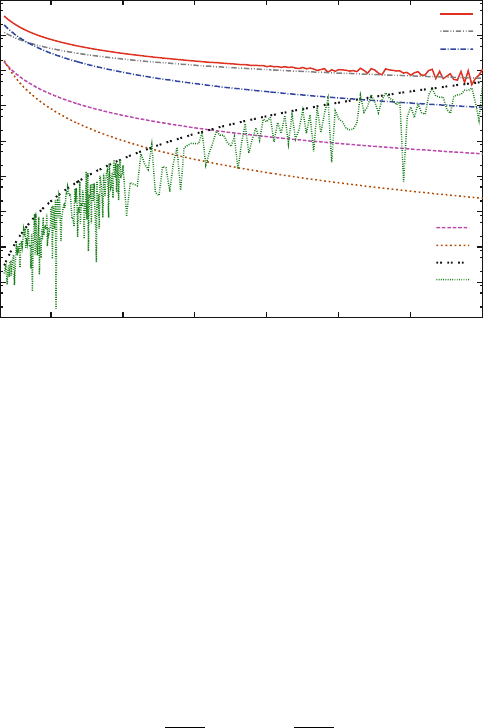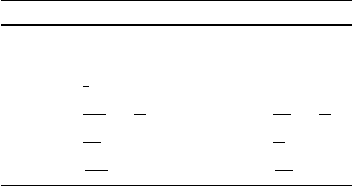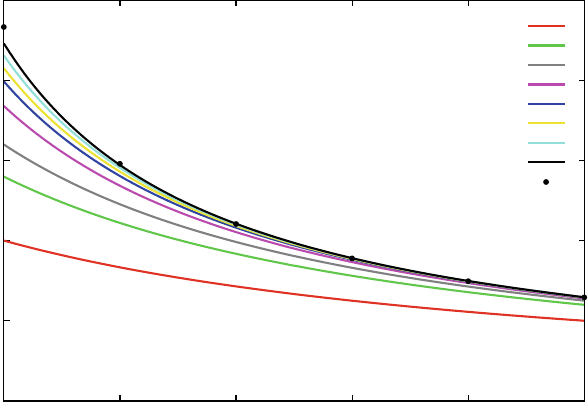Blanchet L., Spallicci A., Whiting B. (Eds.) Mass and Motion in General Relativity
Подождите немного. Документ загружается.


High-Accuracy Comparison Between the PN and SF Dynamics of Black-Hole Binaries 431
u
t
D
.g
˛ˇ
/
1
v
˛
1
v
ˇ
1
c
2
1=2
; (34)
and plug into it the 3PN regularized metric (8), explicitly computed from the 3PN
near-zone expression (18) reduced to binary point masses, and including the 4PN
and 5PN logarithmic corrections computed in Section 6. To begin with, this yields
the expression of u
t
for an arbitrary mass ratio q D m
1
=m
2
, and for a generic
noncircular orbit in a general reference frame. We then choose the frame of the
center of mass, which is consistently defined by the nullity of the center-of-mass
integral of the motion, deduced from the equations of motion. Restricting ourselves
to exactly circular orbits (consistently with the helical Killing symmetry we neglect
radiation-reaction effects), the result is expressed by means of the convenient di-
mensionless gauge-invariant PN parameter
x
Gm˝
c
3
2=3
; (35)
which is directly related to the orbital frequency ˝ of the circular orbit, and depends
on the total mass m D m
1
C m
2
of the binary.
We discover most satisfactorily that all the poles / 1=" (as well as the associated
constant `
0
) cancel out in the final expression for u
t
. Our final result for a 3PN (plus
4PN and 5PN logarithmic terms), gauge-invariant, algebraic relationship between
u
T
(to which u
t
now evaluates) and x (or equivalently ˝), is
6
u
T
.x/ D 1 C
3
4
C
3
4
2
x C
27
16
C
27
16
5
2
5
8
C
2
24
x
2
C
135
32
C
135
32
37
4
67
16
C
115
32
2
C
5
32
2
C
3
48
x
3
C
2835
256
C
2835
256
2183
48
41
64
2
12199
384
41
64
2
C
17201
576
41
192
2
2
C
795
128
2
2827
864
3
C
25
1728
3
C
35
10368
4
x
4
C
A
4
./ C
32
5
32
5
C
64
15
ln x
x
5
C
A
5
./ C
478
105
C
478
105
C
1684
21
C
4388
105
3664
105
2
ln x
x
6
C o.x
6
/: (36)
We introduced the notation .m
2
m
1
/=m D
p
1 4,where D m
1
m
2
=m
2
is
the symmetric mass ratio. While it has been shown in [28] (see also Section 2 above)
6
The Landau o symbol for remainders takes its standard meaning.

432 L. Blanchet et al.
that u
T
is gauge invariant at any PN order in the extreme mass ratio limit 1,here
we find that it is also gauge invariant for any mass ratio up to 3PN order (even up
to 5PN order for the logarithmic terms). This result is expected from (2), according to
which u
T
is a scalar under our hypothesis of helical symmetry. Being proportional to the
symmetric mass ratio , the 4PN and 5PN logarithmic contributions vanish in the test-
mass limit – this is clear given that the Schwarzschild result for u
T
.˝/ does not involve
any logarithm. Notice that the functions A
4
./ and A
5
./ entering the expression of the
non-logarithmic contribution to u
T
.˝/ at the 4PN and 5PN orders are unknown, and
would be very difficult to compute within standard PN theory. However, we know that
they are polynomials in , with leading-order coefficient given by the Schwarzschildean
result (see Eq. 40).
We now investigate the small mass ratio regime q 1, for comparison purposes
with the perturbative SF calculation. We introduce a convenient PN parameter appro-
priate to the small mass limit of particle 1:
y
Gm
2
˝
c
3
2=3
; (37)
which is related to the usual PN parameter x by x D y.1 C q/
2=3
, and to the gauge-
invariant measure (11) of the orbital radius by y D Gm
2
=.R
˝
c
2
/. We also use the
expression of the symmetric mass ratio in terms of the (asymmetric) mass ratio q D
m
1
=m
2
, namely D q=.1 C q/
2
. Our complete redshift observable, expanded through
post-SF order, is of the type
u
T
D u
T
Schw
C q u
T
SF
C q
2
u
T
PSF
C O.q
3
/; (38)
where the Schwarzschild result is known in closed form as u
T
Schw
.y/ D .1 3y/
1=2
.
By expanding the PN result (36)inpowersofq, we find that the SF contribution reads
u
T
SF
.y/ Dy 2y
2
5y
3
C
121
3
C
41
32
2
y
4
C
˛
4
64
5
ln y
y
5
C
˛
5
C
956
105
ln y
y
6
C o.y
6
/: (39)
The coefficients ˛
4
and ˛
5
are pure numbers that parametrize the small mass ratio ex-
pansions of the functions A
4
and A
5
through
A
4
D
15309
256
C
˛
4
25515
128
q C
O.q
2
/; (40a)
A
5
D
168399
1024
C
˛
5
168399
256
q C
O.q
2
/: (40b)
We also give the result for the combination Nu
˛
Nu
ˇ
h
R
˛ˇ
related to u
T
SF
by Eq. 14,since
this is the quantity primarily used in the numerical SF calculation:

High-Accuracy Comparison Between the PN and SF Dynamics of Black-Hole Binaries 433
Nu
˛
Nu
ˇ
O
h
R
˛ˇ
D2y y
2
7
4
y
3
C
1387
24
C
41
16
2
y
4
C
a
4
128
5
ln y
y
5
C
a
5
C
5944
105
ln y
y
6
C o.y
6
/: (41)
We have conveniently rescaled the first-order perturbation h
R
˛ˇ
by the mass ratio q,
denoting
O
h
R
˛ˇ
h
R
˛ˇ
=q.Herea
4
and a
5
denote some unknown pure numbers related to
˛
4
and ˛
5
by
a
4
D 2˛
4
C
9301
64
123
32
2
; (42a)
a
5
D 2˛
5
3˛
4
C
17097
128
369
128
2
: (42b)
The expansions (39)–(41) were determined up to 2PN order / y
3
in [28], based on the
Hadamard-regularized 2PN metric given in [16]. The result at 3PN order / y
4
was ob-
tained in Paper I using the powerful dimensional regularization scheme. By comparing
the expansion (39) with our accurate numerical SF data for u
T
SF
.˝/, we shall be able to
measure the coefficients ˛
4
and ˛
5
(or a
4
and a
5
) with at least eight significant digits
for the 4PN coefficient, and five significant digits for the 5PN coefficient. These results,
as well as the estimation of even higher-order PN coefficients, will be detailed in the
next section.
Similarly, from the PN result (36) valid for any mass ratio q, we get the post-SF
contribution as
u
T
PSF
.y/ D y C 3y
2
C
97
8
y
3
C
725
12
41
64
2
y
4
C "
4
y
5
C
"
5
C
4588
35
ln y
y
6
C o.y
6
/; (43)
which could in principle be compared to a future post-SF calculation making use of
second-order black hole perturbation theory. Note that there is no logarithm at 4PN or-
der in the post-SF term; the next 4PN logarithm would arise at cubic order q
3
,thatis,
at the post-post-SF level. The coefficients "
4
and "
5
in (43) are unknown, and unfortu-
nately they are expected to be extremely difficult to obtain, not only analytically in the
standard PN theory, but also numerically as they require a second-order perturbative SF
scheme.
8 Numerical Evaluation of Post-Newtonian Coefficients
In the SF limit, the SF effect u
T
SF
on the redshift observable u
T
is related via (12)tothe
regularized metric perturbation
O
h
R
˛ˇ
at the location of the particle through

434 L. Blanchet et al.
u
T
SF
D
1
2
.1 3y /
1=2
Nu
˛
Nu
ˇ
O
h
R
˛ˇ
; (44)
where Nu
˛
is the background four-velocity of the particle. Recall that here
O
h
R
˛ˇ
stands
for the perturbation per unit mass ratio,thatis,h
R
˛ˇ
=q. In SF analysis, the combination
Nu
˛
Nu
ˇ
O
h
R
˛ˇ
arises more naturally than u
T
SF
; this is the quantity we shall be interested in
fitting in this section. However, our final results in Table 5 will include the correspond-
ing values of the coefficients for the redshift observable u
T
SF
. We refer to Section II of
Paper I for a discussion of the computation of the regularized metric perturbation
O
h
R
˛ˇ
,
and the invariant properties of the combination Nu
˛
Nu
ˇ
O
h
R
˛ˇ
with respect to the choice of
perturbative gauge. In this section we often use r 1=y, a gauge-invariant measure of
the orbital radius scaled by the black hole mass m
2
(see Eqs. 11 and 37).
Our earlier numerical work in [11,12,28] provided values of the function Nu
˛
Nu
ˇ
O
h
R
˛ˇ
.r/
which cover a range in r from 4 to 750. Following a procedure described in [29], we
have used Monte Carlo analysis to estimate the accuracy of our values for Nu
˛
Nu
ˇ
O
h
R
˛ˇ
.
As was reported in Paper I, this gives us confidence in these base numbers to better
than one part in 10
13
. We denote a standard error representing the numerical error in
Nu
˛
Nu
ˇ
O
h
R
˛ˇ
by
'jNu
˛
Nu
ˇ
O
h
R
˛ˇ
jE 10
13
; (45)
where E ' 1 is being used as a placeholder to identify our estimate of the errors in our
numerical results.
8.1 Overview
A common task in physics is creating a functional model for a set of data. In our prob-
lemwehaveasetofN data points f
i
and associated uncertainties
i
, with each pair
evaluated at an abscissa r
i
. We wish to represent this data as some model function f.r/
which consists of a linear sum of M basis functions F
j
.r/ such that
f.r/ D
M
X
j D1
c
j
F
j
.r/: (46)
The numerical goal is to determine the M coefficients c
j
that yield the best fit in a least
squares sense over the range of data. That is, the c
j
are to be chosen such that
2
N
X
iD1
"
f
i
P
M
j D1
c
j
F
j
.r
i
/
i
#
2
(47)
is a minimum under small changes in the c
j
. For our application we choose the basis
functions F
j
.r/ to be a set of terms that are typical in PN expansions, such as r
1
, r
2
,
..., and also terms such as r
5
ln.r/. We recognize that a solution to this extremum

High-Accuracy Comparison Between the PN and SF Dynamics of Black-Hole Binaries 435
problem is not guaranteed to provide an accurate representation of the data .r
i
;f
i
;
i
/.
The quality of the numerical fit is measured by
2
as defined in Eq. 47. If the model of
the data is a good one, then the
2
statistic itself has an expectation value of the number
of degrees of freedom in the problem, N M , with an uncertainty (standard deviation)
of
p
2.N M/.
Our numerical work leans heavily upon Ref. [42] for solving the extremum problem
for Eq. 47. The numerical evaluation of the fitting coefficient c
j
includes a determina-
tion of its uncertainty ˙
j
which depends upon (i) the actual values of r
i
in use, (ii) all
of the
i
, and (iii) the set of basis functions F
j
.r/. In fact, the estimates of the ˙
j
do
not depend at all on the data (or residuals) being fitted. As a consequence the estimates
of the ˙
j
are only valid if the data are well represented by the set of basis functions.
For emphasis, the ˙
j
depend upon F
j
.r
i
/ and upon
i
but are completely independent
of the f
i
. Only if the fit is considered to be good, could the ˙
j
give any kind of real-
istic estimate for the uncertainty in the coefficients c
j
. If the fit is not of high quality
(unacceptable
2
), then the ˙
j
bear no useful information [42]. We will come back to
this point in the discussion below.
We also should remark that the task of determining coefficients in the 1=r charac-
terization of our numerical data is almost incompatible with the task of determining
an asymptotic expansion of Nu
˛
Nu
ˇ
O
h
R
˛ˇ
from an analytic analysis. Analytically, the strict
r !C1limit is always technically possible, whereas numerically, not only is that
limit never attainable, but we must always contend with function evaluations at just a
finite number of discrete points, obtained within a finite range of the independent vari-
able, and computed with finite numerical precision. Nevertheless, this is what we have
done below.
The numerical problem is even more constrained than we have just indicated. At
large r, even though the data may still be computable there, the higher order terms for
which we are interested in evaluating PN coefficients rapidly descend below the error
level of our numerical data. This is clearly evident in Fig. 2 below. For small r,the
introduction of so many PN coefficients is necessary that it becomes extremely difficult
to characterize our numerical data accurately. Thus, in practice, we find ourselves ac-
tually working with less than the full range of our available data. At large r we could
effectively drop points because they contribute so little to any fit we consider. At the
other extreme, the advantage of adding more points in going to smaller r is rapidly out-
weighed by the increased uncertainty in every fitted coefficient. This results from the
need to add more basis functions in an attempt to fit the data at small r. Further details
will become evident in Section 8.4 below.
8.2 Framework for Evaluating PN Coefficients Numerically
In a generic fashion we describe an expansion of Nu
˛
Nu
ˇ
O
h
R
˛ˇ
in terms of PN coefficients
a
j
and b
j
with
Nu
˛
Nu
ˇ
O
h
R
˛ˇ
D
X
j >0
a
j
r
j C1
ln r
X
j >4
b
j
r
j C1
; (48)

436 L. Blanchet et al.
1e-08
1e-07
1e-06
1e-05
1e-04
0.001
0.01
0.1
1
10
100 200 300 400 500 600 700
r
5
uuh
y
−1
r
5
(uuh-5PNL)
5PN
6PN
6PNL
7PN
err
|res|
Fig. 2 The absolute value of the contributions of the numerically determined post-Newtonian
terms to r
5
Nu
˛
Nu
ˇ
O
h
R
˛ˇ
. Here PNL refers to just the logarithm term at the specified order. The contri-
bution of a
4
is not shown but would be a horizontal line (since the 4PN terms behaves like r
5
)
at approximately 121.3. The remainder after a
4
and all the known coefficients are removed from
r
5
Nu
˛
Nu
ˇ
O
h
R
˛ˇ
is the top (red) continuous line. The lower (black) dotted line labelled “err” shows the
uncertainty in r
5
Nu
˛
Nu
ˇ
O
h
R
˛ˇ
, namely 2E r
4
10
13
. The jagged (green) line labeled “jresj”isthe
absolute remainder after all of the fitted terms have been removed. The figure reveals that, with
regard to the uncertainty of the calculated Nu
˛
Nu
ˇ
O
h
R
˛ˇ
, the choice E ' 1 was slightly too large
where a
0
is the Newtonian term, a
1
is the 1PN term, and so on. Similarly, for use in
applications involving u
T
we also introduce the coefficients ˛
j
and ˇ
j
in the expansion
of the SF contribution
u
T
SF
D
X
j >0
˛
j
r
j C1
ln r
X
j >4
ˇ
j
r
j C1
: (49)
These series allow for the possibility of logarithmic terms, which are known not to
start before the 4PN order. We also concluded in Paper II that .ln r/
2
terms cannot arise
before the 5.5PN order. Since we are computing a conservative effect, possible time-odd
logarithmic squared contributions at the 5.5PN or 6.5PN orders do not contribute. But
there is still the possibility for a conservative 7PN .ln r/
2
effect, probably originating
from a tail modification of the dissipative 5.5PN .ln r/
2
term. However, we shall not
permit for such a small effect in our fits. As discussed below in Section 8.4, we already
have problems distinguishing the 7PN linear ln r term from the 7PN non-logarithmic
contribution.
The analytically determined values of the coefficients a
0
, a
1
, a
2
, a
3
, b
4
, b
5
and ˛
0
,
˛
1
, ˛
2
, ˛
3
, ˇ
4
, ˇ
5
computed in Ref. [28] and Papers I and II are reported in Table 1.

High-Accuracy Comparison Between the PN and SF Dynamics of Black-Hole Binaries 437
Table 1 The analytically
determined PN coefficients
for Nu
˛
Nu
ˇ
O
h
R
˛ˇ
(left)andu
T
SF
(right)
Coeff. Value Coeff. Value
a
0
2˛
0
1
a
1
1˛
1
2
a
2
7
4
˛
2
5
a
3
1387
24
C
41
16
2
˛
3
121
3
C
41
32
2
b
4
128
5
ˇ
4
64
5
b
5
C
5944
105
ˇ
5
C
956
105
8.3 Consistency Between Analytically and Numerically
Determined PN Coefficients
In this section, we investigate the use of our data for Nu
˛
Nu
ˇ
O
h
R
˛ˇ
and the fitting procedures
we have described above (and expanded upon in the beginning of Section 8.4). We will
begin by fitting for enough of the other PN coefficients to be able to verify numerically
the various coefficients a
3
, b
4
,andb
5
now known from PN analysis.
As a first step in this section, we will complete the task that was begun in [28],
namely, the numerical determination of the coefficient a
3
(and ˛
3
), this time taking
fully into account the known logarithmic terms at 4PN and 5PN orders. For illustrative
purposes only, these results are given in Table 2. We were able to obtain a fit with six
undetermined parameters, and could include data from r D 700 down to r D 35.Note
that, with the inclusion of the b
4
and b
5
coefficients, the precision of our tabulated value
for a
3
has increased by more than four orders of magnitude from Paper I, although
our accuracy is still no better than about 2˙. Such a discrepancy is not uncommon.
The uncertainty, ˙ , reflects only how well the data in the given, finite range can be
represented by a combination of the basis functions. It is not a measure of the quality of
a coefficient when considered as a PN expansion parameter, which necessarily involves
an r !C1limiting process.
Our next step is to include the known value for a
3
and to use our numerical data
to estimate values for the b
4
and b
5
coefficients. Our best quality numerical result was
obtained with five fitted parameters, over a range from r D 700 down to only r D 65,
and is given in the first row of Table 3. Notice that while our b
4
is determined relatively
precisely, it has only about 6˙ accuracy. The higher order coefficient b
5
is more difficult
to obtain and, at this point, it is very poorly determined, but we can use the known value
of b
4
in order to improve the accuracy for b
5
. These results are presented in Table 3,
which again shows that we needed to fit for a total of six parameters to get a result of
reasonable accuracy. With this, we have reached a limit for treating our data in this way,
since adding further parameters and inner points does not result in any higher quality fit.
By now we have presented enough to show that we have data which allows high
precision, with an accuracy that we now have some experience in relating to the com-
puted error estimates. This experience will be valuable when we come to discuss further
results in the next section. For convenience, we summarize the relevant information fur-
ther, in Table 4, referring just to our estimates of known PN parameters, and relating
our error estimates to the observed accuracy.

438 L. Blanchet et al.
Table 2 The results of a numerical fit for a set of six coefficients that includes a
3
, which is now
known analytically [11]. This fit uses the known results for b
4
and b
5
[12], but not the known value
of a
3
. Thus, it is not the best fit of our data possible. The uncertainty in the last digit or two is in
parentheses. The range runs from r D 35 to r D 700, with 266 data points and a respectable
2
of 264
3PN coeff. Ref. [28] Paper I Paper II PN (exact)
a
3
32:34.6/ 32:479.10/ 32:5008069.7/ 32:50080538
˛
3
27:61.3/ 27:677.5/ 27:6879035.4/ 27:68790269
Table 3 The numerically determined PN coefficients for Nu
˛
Nu
ˇ
O
h
R
˛ˇ
. Each row represents a different
fit. The first two columns give the starting point r
min
at the inner boundary of the fitting range, and
the value of
2
statistic per degree of freedom (dof) for the chosen fit. The degrees of freedom,
N M , for the fit, range between 212 and 255, depending on r
min
. If a value for a coefficient is not
shown, then either that parameter was not included in that particular fit (far right) or its analytically
known value was used (e.g., b
4
). The formal uncertainty of a coefficient in the last digit or two is
in parentheses. The outer boundary is at 700 in each case
r
min
2
=dof a
4
b
4
a
5
b
5
a
6
b
6
a
7
65 0.961 121:40.1/ 25:612.2/ 102.1/ 45:5.3/ 2081.9/
85 0.976 121:3180.7/ 91:5.7/ 48:5.2/ 2170.8/
65 0.961 121:313.1/ 79.2/ 50:6.4/ 1868.44/ 131.21/
40 0.969 121:3052.6/ 47.1/ 55:7.2/ 359.41/ 625.15/ 7722.162/
Table 4 Comparing the analytically known PN coefficients (column 5) with their numerically
determined counterparts (column 3), and comparing the numerically determined error estimates
(column 3) with the apparent accuracy (column 4). The source of the data is given in column 1
Source Coeff. Estimate Accuracy Exact result
Paper I ˛
3
27:677.5/ ! .11/ 27:6879
Table 2 a
3
32:5008069.7/ ! .15/ 32:50080538
Table 3 b
4
25:612.2/ ! .12/ 25:6
Table 3 b
5
C55:7.2/ ! .9/ C56:6095
8.4 Determining Higher Order PN Terms Numerically
In this section we make maximum use of the coefficients which are already known. We
find that in our best-fit analysis we can use a set of five basis functions corresponding
to the unknown coefficients a
4
, a
5
, a
6
, b
6
and a
7
.
In Table 5, we describe the numerical fit of our data over a range in r from 40
to 700.The
2
statistic is 259 and slightly larger than the degrees of freedom, 256,
which denotes a good fit. Further, we expect that a good fit would be insensitive to
changes in the boundaries of the range of data being fit, and we find, indeed, that if the
outer boundary of the range decreases to 300 then essentially none of the data in the
table changes, except for
2
and the degrees of freedom which decrease in a consistent
fashion. Figure 2 shows that in the outer part of the range Nu
˛
Nu
ˇ
O
h
R
˛ˇ
is heavily dominated

High-Accuracy Comparison Between the PN and SF Dynamics of Black-Hole Binaries 439
Table 5 The numerically determined values of higher-order PN coef-
ficients for Nu
˛
Nu
ˇ
O
h
R
˛ˇ
(left) and for u
T
SF
(right). The uncertainty in the last
digit or two is in parentheses. The range runs from r D40 to r D700,
with 261 data points being fit. The
2
statistic is 259. We believe that
a contribution from a b
7
confounds the a
7
coefficient. Both terms fall
off rapidly and have influence over the fit only at small r.Andthera-
dial dependence of these two terms only differ by a factor of ln r [or
possibly .ln r/
2
; see Paper II] which changes slowly over their limited
range of significance
Coeff. Value Coeff. Value
a
4
121:30310.10/ ˛
4
114:34747.5/
a
5
42:89.2/ ˛
5
245:53.1/
a
6
215.4/ ˛
6
695.2/
b
6
C680.1/ ˇ
6
C339:3.5/
a
7
8279.25/ ˛
7
5837.16/
by only a few lower order terms in the PN expansion – those above the lower black
double-dashed line in the figure.
The inner edge of the range is more troublesome. The importance of a given higher
order PN term decreases rapidly with increasing r. Moving the inner boundary of the
range outward might move a currently well determined term into insignificance. This
could actually lead to a smaller
2
, but it would also lead to an increase in the ˙
j
of every coefficient. Moving the inner edge of the range inward might require that
an additional higher order term be added to the fit. This extra term loses significance
quickly with increasing r so the new coefficient will be poorly determined and also
result in an overall looser fit with an increase of ˙
j
for all of the coefficients. If the inner
boundary and the set of basis functions are chosen properly, then a robust fit is revealed
when the parameters being fit are insensitive to modest changes in the boundaries of the
range. The fit described in Table 5 appears to be robust. The parameters in this Table
are consistent with all fits with the inner boundary of the range varying from 35 to 45
and the outer boundary varying from 300 to 700.
If an additional term, with coefficient b
7
, is added to the basis functions then, for
identical ranges, each of the ˙
j
increases by a factor of about 10, and the changes
in a
4
and a
5
are within this uncertainty. The coefficient a
6
changes sign and b
6
and
a
7
change by an amount significantly larger than the corresponding ˙
j
.Andthenew
coefficient b
7
is quite large. In the context of fitting data to a set of basis functions these
are recognized symptoms of over-fitting and imply that the extra coefficient degrades
the fit.
8.5 Summary
Our best fit can be visualized in Fig. 3, where we plot the SF effect u
T
SF
on the redshift
variable u
T
as a function of r D y
1
, as well as several truncated PN series up to
7PN order, based on the analytically determined coefficients summarized in Table 1,

440 L. Blanchet et al.
0.1
0
0.2
0.3
0.4
0.5
−u
T
SF
56789
10
y
−1
N
1PN
2PN
3PN
4PN
5PN
6PN
7PN
Exact
Fig. 3 The self-force contribution u
T
SF
to the redshift observable u
T
, plotted as a function of the
gauge-invariant variable y. Note that y
1
is an invariant measure of the orbital radius scaled by the
black hole mass m
2
(see Eqs. 11 and 37). The “exact” numerical points are taken from Ref. [28].
Here, PN refers to all terms, including logarithms, up to the specified order (however recall that we
did not include in our fit a log-term at 7PN order)
as well as our best fit of the higher-order PN coefficients reported in Table 5.Observe
in particular the smooth convergence of the successive PN approximations toward the
exact SF results. Note, though, that there is still a small separation between the 7PN
curve and the exact data in the very relativistic regime shown at the extreme left of
Fig. 3.
We have found that our data in the limited range of 35 6 r 6 700 can be extremely
well characterized by a fit with five appropriately chosen (basis) functions. That is,
the coefficients in Table 5 are well determined, with small uncertainties, and small
changes in the actual details of the fit result in coefficients lying within their error
estimates. Fewer coefficients would result in a very poor characterization of the same
data while more coefficients result in large uncertainties in the estimated coefficients,
which themselves become overly sensitive to small changes in specific details (such
as the actual choice of points to be fitted). In practice, over the data range we finally
choose, and with the five coefficients we fit for, we end up with exceedingly good results
for the estimated coefficients, and with residuals which sink to the level of our noise.
We have a very high quality fit which is quite insensitive to minor details. Nevertheless,
as Table 4 hints, error estimates for these highest order coefficients should be regarded
with an appropriate degree of caution.
